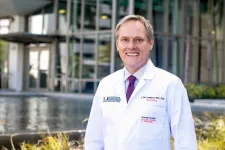(Press-News.org)
Despite the fact that people with sickle cell disease have a much higher risk of serious illness or death if they develop COVID-19, a new study shows they’re also much less likely than those without sickle cell disease to have gotten vaccinated against coronavirus.
Completion of the initial COVID-19 vaccination series was nearly two times lower for adults with sickle cell disease as others their age, the analysis of data in Michigan shows.
In in teens and children over 5, who overall have lower rates of COVID-19 vaccination, those with sickle cell disease were far less likely than other young people to have gotten their doses by summer 2022, the analysis shows.
A team from Michigan Medicine, the University of Michigan’s academic medical center, published the findings in JAMA Network Open together with colleagues from the Michigan Department of Health and Human Services and U-M School of Public Health.
The team behind the study runs the Michigan Sickle Cell Data Collection Program (MiSCDC), part of the national Sickle Cell Data Collection Program funded by the Centers for Disease Control and Prevention.
To produce the findings, the team linked individual-level data from the statewide sickle cell data collection program and immunization registry. In all, they had records from 3,424 people over age 5 with sickle cell disease, and 9.4 million Michiganders over age 5.
In all, 61% of the Michiganders without sickle cell disease, but only 33.5% of those with sickle cell disease, had gotten at least the primary dose or doses of Pfizer, Moderna or Johnson & Johnson COVID-19 vaccines by August 2022.
The very highest-risk group, those over 65, had the highest vaccination rates, at 74% for those with sickle cell disease and 87% for the general population. However, there are only 110 people with sickle cell disease in this age group due to a combination of early mortality and less comprehensive data for this age group.
In adults age 18 to 64, the difference between the two groups was about the same as the overall average.
But in children and teens with sickle cell disease, who the researchers had previously shown have a higher rate of hospitalization and death if they developed COVID-19 compared to young people without sickle cell disease, vaccination rates were much lower.
Only 17% of children age 5 to 11 with sickle cell disease, and 31% of their counterparts age 12 to 17, had gotten even a primary series of COVID-19 vaccine. That’s compared with 25% and 41% of the general Michigan population in these age groups.
"It is essential to develop targeted interventions to increase COVID-19 vaccination among people with sickle cell disease," says MiSCDC principal investigator Sarah Reeves, Ph.D. "This population is chronically underserved in healthcare and society, emphasizing the importance of increasing the accessibility and acceptability of these vaccines."
The lead author of the study is Hannah Peng, M.P.H., a senior statistician on the MiSCDC team. Both she and Reeves are members of the Susan B. Meister Child Health Evaluation and Research (CHEAR) Center in the U-M Department of Pediatrics. Reeves and co-authors Kevin Dombkowski, Dr.P.H., of Pediatrics and Melissa Creary, Ph.D., of U-M SPH, are members of the U-M Institute for Healthcare Policy and Innovation.
The study was funded by the Centers for Disease Control and Prevention.
COVID-19 Immunization Coverage Among People With Sickle Cell Disease, JAMA Network Open, doi:10.1001/jamanetworkopen.2023.51618
END
The Brookline Housing Authority (BHA) has partnered with Hebrew SeniorLife, New England’s largest nonprofit provider of senior health care and living communities, and the only senior care organization affiliated with Harvard Medical School, to provide community life services including resident services, fitness, social programming, and nursing in BHA’s senior housing sites.
Hebrew SeniorLife brings to the BHA its model of housing with services called the Right Care, Right Place, Right Time (R3) program. This model uses a preventive approach to resident services, focused on one-on-one relationship building, community-wide ...
MIAMI, FLORIDA (EMBARGOED UNTIL JAN. 9, 2024 AT 4 PM EST) – A multicenter collaboration led by researchers at Sylvester Comprehensive Cancer Center at the University of Miami Miller School of Medicine has produced the first computational model for newly diagnosed multiple myeloma that predicts an individual’s personalized prognosis based on their tumor genomics and treatments.
The prediction model for individualized risk in newly diagnosed multiple myeloma, or IRMMa, improves on previous prognostic tools because it takes into account ...
“Identifying plasma proteins that regenerate aged or damaged ovaries could lead to more effective, targeted and/or preventive therapies for patients.”
BUFFALO, NY- January 9, 2024 – A new research paper was published in Aging (listed by MEDLINE/PubMed as "Aging (Albany NY)" and "Aging-US" by Web of Science) Volume 15, Issue 24, entitled, “Systemic changes induced by autologous stem cell ovarian transplant in plasma proteome of women with impaired ovarian reserves.”
Patients with poor ...
People who own electric vehicles (EVs) are more likely to go a step further and add solar panels to their home, according to an analysis of a behavioral study by researchers at the U.S. Department of Energy’s National Renewable Energy Laboratory (NREL). Conversely, the impact of owning solar panels also has a bearing on whether a homeowner buys an electric vehicle but not as strongly.
The study relied on a survey of 869 households in the San Francisco Bay Area.
NREL’s Shivam Sharda, lead author of the newly published research paper that analyzes the ...
University of Colorado Cancer Center member Sana Karam, MD, PhD, has received a translational research grant from the V Foundation for Cancer Research, co-founded by ESPN and legendary basketball coach Jim Valvano, to study a new therapeutic that may help pancreatic cancer patients overcome resistance to radiation therapy.
“Pancreatic cancer is deadly. The only treatment that can cure it is surgery to fully remove the tumor, but that is only an option when the cancer is caught early, which is rare,” Karam explains. “Radiation alone to shrink tumors before surgery has been tried, but with limited benefit. By studying patient ...
New research overseen by University of Colorado Cancer Center member Rebecca Schweppe, PhD, could lead to improved treatment for people with thyroid cancer characterized by a mutation in the BRAF gene — a mutation also responsible for some types of melanoma, colorectal cancer, leukemia, lymphoma, and ovarian cancer.
“The BRAF mutation is a common mutation in thyroid cancer,” Schweppe says. “It has a high prevalence of mutations in two different subtypes — papillary thyroid cancer, or PTC, and anaplastic thyroid cancer, or ATC — and there's a lot of interest in targeting this pathway. Other tumor types, like melanoma ...
Waltham — January 8, 2024 — Proper procedures for diagnosing prolonged grief disorder (PGD) are not being followed in research into its prevalence, according to a study published in Harvard Review of Psychiatry, part of the Lippincott portfolio from Wolters Kluwer. What’s more, most published literature doesn’t clearly acknowledge the limitations of the methodology used.
The lead investigator was Margaret S. Stroebe, PhD, a clinical psychologist at Utrecht University and the University of Groningen ...
The University of Rochester will house a new national center focused on using tissue-on-chip technology to develop drugs more rapidly and reduce the need for animal trials. The National Institutes of Health awarded a $7.5 million grant to establish the Translational Center for Barrier Microphysiological Systems (TraCe-bMPS) at Rochester in partnership with Duke University.
The center aims to develop five Food and Drug Administration–qualified drug development tools related to ...
Police reform movements often focus on improving police-public relationships. These ties are a focus of community policing and procedural justice, two significant reform efforts in policing worldwide over the last three decades. In a new article, researchers examine issues involved in these efforts, especially limitations to communication, and highlight implications for police-community relations.
The article, by researchers at Arizona State University (ASU) and the University of California, Santa Barbara (UCSB), is published in Psychology, Public Policy, and the Law.
“Reform movements that try to improve relationships ...
Managing public order at large demonstrations, protests, and assemblies is a demanding and necessary task. A new book provides an international review of public order management experiences and effective practices. Through practical examples grounded in multidisciplinary theory and science, the book offers a roadmap to improve police response and increase safety at large gatherings in democratic countries.
The book, Public Order Policing: A Professional's Guide to International Theories, Case Studies, and Best Practices, was edited by researchers at the University of Nevada, Las Vegas (UNLV); ...


